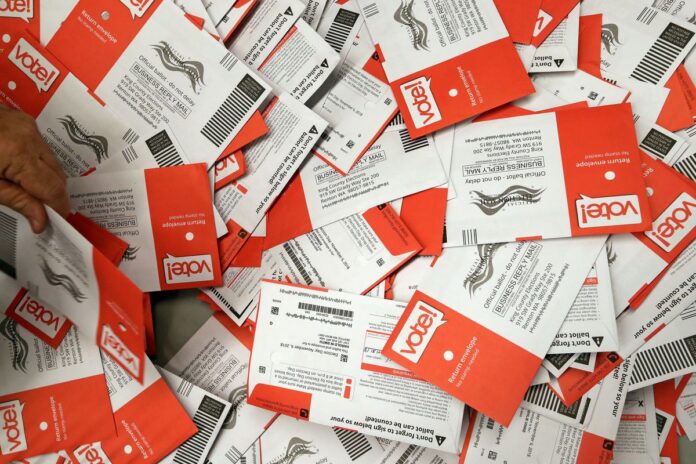The Supreme Court will likely weigh in on Pennsylvania’s handling of mail-in ballots, and despite the pundits’ claims to the contrary, serious constitutional issues are at stake.
An exclusive interview establishes the Pennsylvania vote has major constitutional problems. Joe Kantz, the chairman of the Snyder County Commission and the chairman of the Board of Elections for more than 10 years, spoke with me yesterday about the last-minute changes the Pennsylvania secretary for elections and commissions issued. As detailed below, those changes strongly suggest that the electorally rich state the media has called for Joe Biden might have violated the Equal Protection Clause and Article II, Section 1, Clause 2 of the U.S. Constitution.
On election morning, as his team began pre-canvass activities, an out-of-state Democratic poll watcher pressured Kantz to provide him identification numbers for voters who had failed to include their ballots in the internal secrecy sleeve required by Pennsylvania law. These so-called naked ballots are invalid under Pennsylvania law.
This gentleman pushed Kantz several times for this information, referencing an email from Jonathan Marks, the deputy secretary for elections and commissions. “He showed me the email, which I had not yet seen,” Kantz told me. Kantz’s election director then checked her email and discovered the 8:38 p.m. Monday email from Marks.
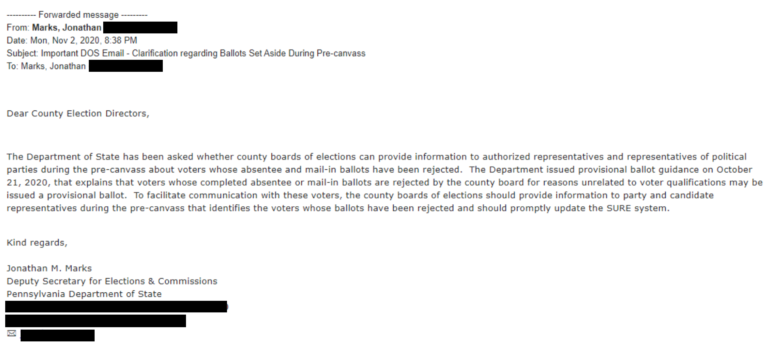
Marks’ last-minute email noted that county boards of elections had asked whether they could provide representatives of candidates or political parties information about voters whose absentee and mail-in ballots had been rejected. Marks advised that the county board of elections should provide this information to party and candidate representatives during the pre-canvass.
“I consulted with our solicitor concerning the directive,” Kantz told me. He apparently spoke with attorneys for other counties before advising that he did not believe the Pennsylvania election code provided for the sharing of voter identification information with third parties.
Snyder County, which is nestled in the middle of Pennsylvania under the shadow of the Appalachian Mountain range, leans heavily Republican, with the unofficial results showing the Donald Trump-Mike Pence ticket received 13,816 votes to Biden-Harris’s 4,848. “About 60 ballots failed to include the inner sleeve as required by Pennsylvania law, rendering the votes invalid,” Kantz told me. “Approximately 25 additional voters had failed to sign the outer envelope,” another mandate of Pennsylvania law.
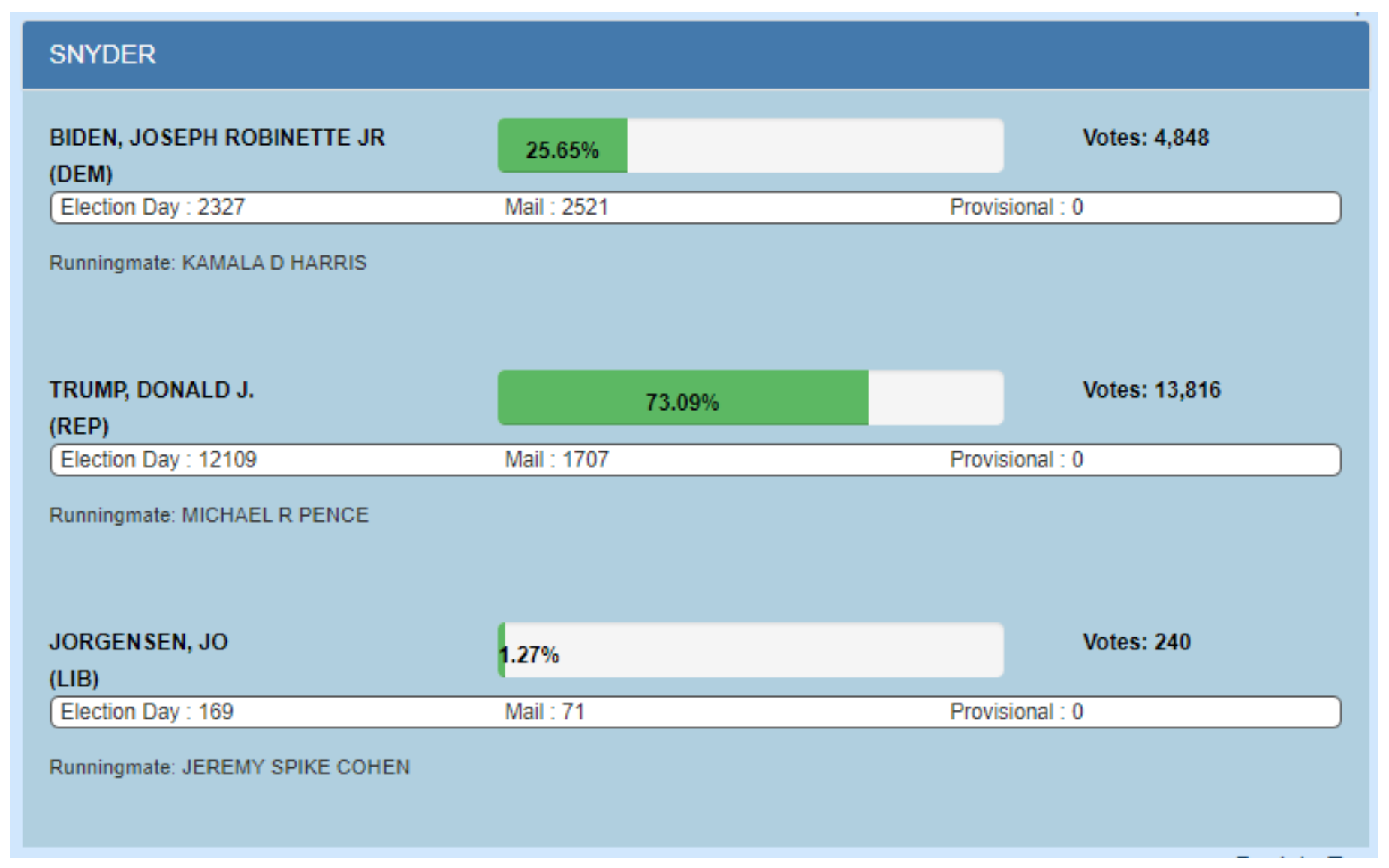
With more than 47,000 votes separating Biden and Trump in the statewide tallies, those 80-plus ballots in the small Snyder County won’t change the outcome in Pennsylvania. What might change the outcome, however, is the different treatment voters with invalid ballots received in larger, heavily Democratic areas, such as Philadelphia County, which recorded a whopping 575,975 votes for Biden-Harris compared to Trump’s 128,308, with more than 56 percent of Biden voters using mail-in voting.
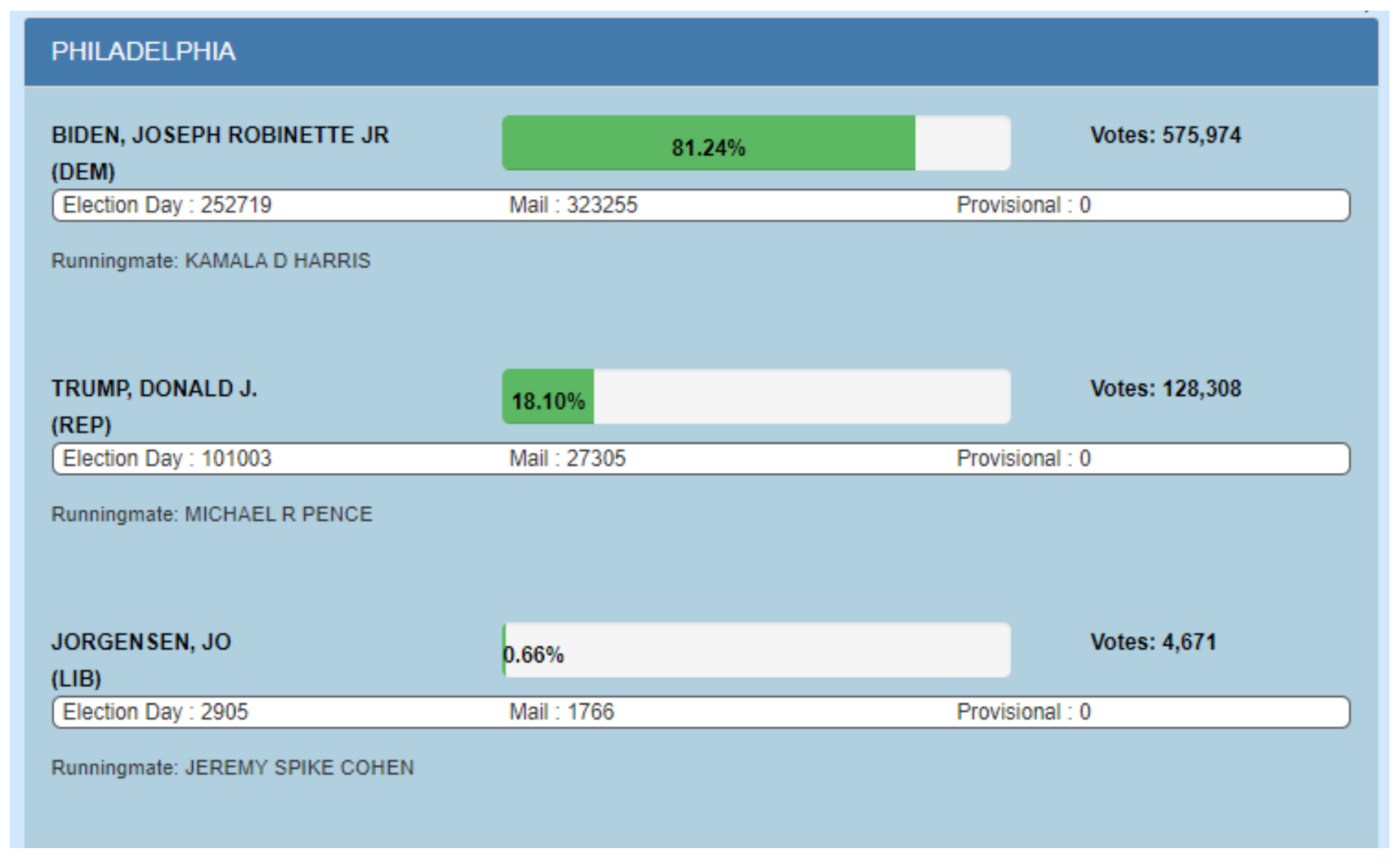
According to a complaint filed on Monday on behalf of Trump, Philadelphia County allowed voters it had determined had submitted naked ballots to remedy the defect, and further alleged that to figure out which voters should be notified of their error, Philadelphia County inspected mail-in ballots before Election Day in plain violation of state law.
Specifically, Section 13808(g)(1.1) of the election code provides that “no earlier than seven o’clock A.M. on election day,” the county board of elections shall meet to conduct a pre-canvass of all absentee and mail-in ballots received to that meeting.” At that meeting, “the election officials shall inspect and open the envelopes of all absentee and mail-in ballots, remove such ballots from such envelopes, and count, compute and tally the votes reflected on such ballots,” 25 P.S. §3146.8(1.1).
Details of the Trump Complaint
Trump’s complaint charged that Philadelphia County officials inspected the ballots in a variety of ways to determine if they were missing an inner-secrecy envelope, for example, by feeling the envelope, holding it up to a light, or weighing it through sorting machines.
Trump’s allegations find support in an election update published by Election Protection. Election Protection, also known as 866-Our-Vote, “was founded in 2004 by a coalition of major left-leaning advocacy organizations,” and now partners with an array of leftist groups, including the National Education Association, Service Employees International Union, American Federation of Teachers, Sierra Club, Southern Poverty Law Center, Common Cause, People for the American Way, and the Al Sharpton group, National Action Network.https://26718603198b565b094cba6b087ce23f.safeframe.googlesyndication.com/safeframe/1-0-37/html/container.html
In the days before the 2020 election, Election Protection issued various updates, including one on Oct. 30, 2020, which noted that voters in Pennsylvania might start getting emails that their ballots were rejected because voters had failed to sign the outside envelope or that it was weighed and determined to be a naked ballot. The Election Protection update continued:
Counties have had varying ability to identify and set aside returned absentee and mail-in ballots lacking the secrecy envelope and/or a signature on the declaration envelope. Larger counties with more sophisticated equipment could automate this process, but smaller county offices would have to do this by hand. While the absence of a signature is plainly knowable, determining whether a ballot is properly enclosed in the secrecy envelope may not be straightforward. The Bluecrest sorting equipment used in Philadelphia and several other large [areas] can detect naked ballots by the thickness and/or weight of the returned ballot.
In bolded language, highlighted in yellow, Election Protection then advised that the best option for citizens under these circumstances was to visit a polling place on Election Day to re-vote, adding that the Department of State had recently clarified that such votes would be counted so long as the voter was eligible to vote.
Trump’s complaint alleged that this approach is exactly what happened in the defendant counties, which included Allegheny, Centre, Chester, Delaware, Montgomery, Northampton, and Philadelphia counties. Those counties’ boards of election, according to the complaint, allowed voters to fix their defective mail-in ballots, while other counties, such as the Republican-heavy counties of Lancaster, York, Westmoreland, and Berks counties, did not contact voters who had submitted naked ballots, nor allow them a chance to re-vote.
Discrepancies Between Red and Blue Counties
When asked whether his election workers had attempted to determine if there were naked ballots inside the mail-in ballots before election day, Kantz told me, “No. State law prohibits pre-canvassing of ballots until Election Day,” so his staff could not attempt to decipher whether the ballots inside lacked the inner security sleeve.
“We did not know if a ballot was naked until we opened the outer envelope on Election Day,” Kantz explained. As noted above, Kantz also refused to provide third-party poll watchers with identification numbers for voters whose ballots lacked a signature or an interior secrecy sleeve.
While Pennsylvania’s Department of State had provided guidance that such voter information should be shared with candidates or party representatives, that guidance conflicts with the election code provisions governing canvassing of absentee and mail-in ballots. “No person observing, attending or participating in a pre-canvass meeting may disclose the results of any portion of any pre-canvass meeting prior to the close of the polls,” 25 P.S. § 3146.8(g)(1.1) provides.
Yet the Democratic strongholds were doing just that, according to Trump’s complaint. Further, as this social media post reveals, Democrats appeared prepared for the Department of State’s last-minute announcement, seeking workers to contact voters on Election Day.
Significantly, the post noted that training would occur on Nov. 2 at 2:30 p.m. and foresaw that on Election Day, the campaign would receive “information about rejected ballots.” (The Department of State’s email to county election officials directing them to provide information concerning voters with rejected ballots to party and candidate representatives was not dispatched until after 8:00 p.m. on Nov. 2.) Workers would then be dispatched to the voters’ homes and tell them they needed to re-vote.
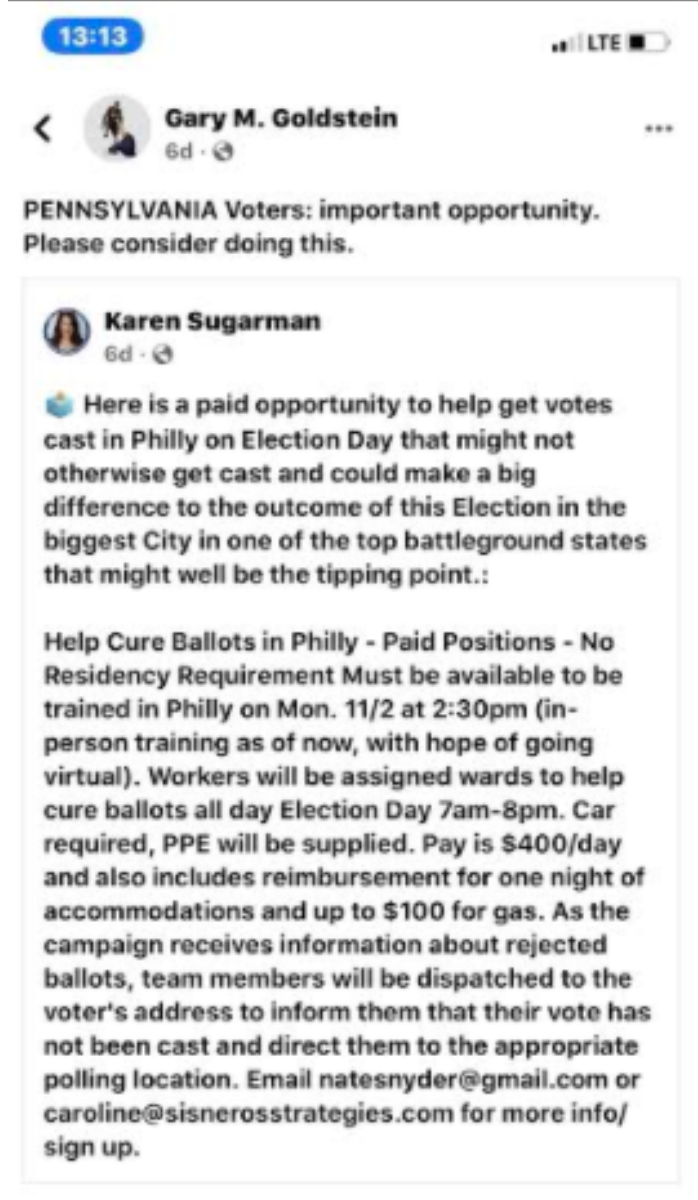
This solicitation directed interested applicants to contact Sisneros Strategies, which promotes itself as helping “campaigns, progressive and pro-labor candidates and organizations, ballot initiatives, state caucuses, state parties, and nonprofit organizations achieve their voter contact goals.”
A Look Back at Bush v. Gore
These facts, when read in light of the U.S. Supreme Court decision in Bush v. Gore, provide strong support for aspects of Trump’s lawsuit. As Andrew McCarthy concisely summarized:
In that famous 2000 election case, the Supreme Court called a halt to the state supreme court’s recount process in Florida. The 5–4 majority found that the state court’s rulings, as the counties in question were executing them, had resulted in widely disparate treatment of voters during the canvassing of ballots across counties — and sometimes within the same county. The Court reasoned that disparate treatment that has the effect of canceling or diluting some voters’ votes, or that privileges some voters but not others, is unconstitutional.
Here, revisiting the Court’s reasoning in Bush v. Gore is helpful to consider how that precedent applies to the Pennsylvania situation. The majority in Bush v. Gore held that the varying standards violated the Equal Protection Clause of the Constitution, reasoning: “The right to vote is protected in more than the initial allocation of the franchise. Equal protection applies as well to the manner of its exercise. Having once granted the right to vote on equal terms, the State may not, by later arbitrary and disparate treatment, value one person’s vote over that of another.”
Yet that is exactly what happened to Pennsylvania voters in at least two ways. First, only voters in larger counties with access to “Bluecrest sorting equipment” could benefit from the pre-canvass sorting of ballots to determine which votes would be canceled because of a missing secrecy sleeve. Second, there was disparate treatment between residents in counties that inspected the ballots pre-canvass and then provided third parties the voters’ information, and those that did not. Under Bush v. Gore, this seems a clear violation of the Equal Protection Clause.
The situation in Pennsylvania brings up another constitutional concern, one raised in the three-justice concurrence authored by then-Justice William Rehnquist and joined by former Justice Antonin Scalia and current Justice Clarence Thomas. In his concurrence, Rehnquist focused not on the Equal Protection Clause but on Article II, Section 1, Clause 2, of the U.S. Constitution, which provides, “Each state shall appoint, in such manner as the Legislature thereof may direct, a number of electors, equal to the whole number of Senators and Representatives to which the State may be entitled in the Congress.”
The Bush v. Gore concurrence then explained that Article II, Section 1, Clause 2 of the Constitution “convey[s] the broadest power of determination” and “leaves it to the legislature exclusively to define the method” of appointment of electors. And “a significant departure from the legislative scheme for appointing Presidential electors presents a federal constitutional question.” The three-justice concurrence then explained how the Florida Supreme Court’s decision conflicted with the legislative mandate in violation of Article II.
In Pennsylvania, it was the Department of State, not the state courts, that significantly departed from the legislative scheme by, among other things, allowing the inspection of ballots before the day of the election and by permitting voter-information to be shared before the close of the polls on Election Day. The Trump team presents several other examples of violations of the election code, for instance, related to the curing of mail-in ballots and the failure to verify signatures.
How these arguments will play out is anyone’s guess, given the new makeup of the Supreme Court, but as the concurrence stressed: “We deal here not with an ordinary election, but with an election for the President of the United States. The importance of his election and the vital character of its relationship to and effect upon the welfare and safety of the whole people cannot be too strongly stated.”
This reality will likely force the Supreme Court to weigh in on Pennsylvania’s handling of the mail-in ballots under both the Equal Protection Clause and Article II. Notwithstanding pundits’ claims to the contrary, serious constitutional issues are at stake.

